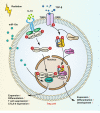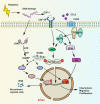Radiotherapy combined with immunotherapy: the dawn of cancer treatment
- PMID: 35906199
- PMCID: PMC9338328
- DOI: 10.1038/s41392-022-01102-y
Radiotherapy combined with immunotherapy: the dawn of cancer treatment
Abstract
Radiotherapy (RT) is delivered for purposes of local control, but can also exert systemic effect on remote and non-irradiated tumor deposits, which is called abscopal effect. The view of RT as a simple local treatment has dramatically changed in recent years, and it is now widely accepted that RT can provoke a systemic immune response which gives a strong rationale for the combination of RT and immunotherapy (iRT). Nevertheless, several points remain to be addressed such as the interaction of RT and immune system, the identification of the best schedules for combination with immunotherapy (IO), the expansion of abscopal effect and the mechanism to amplify iRT. To answer these crucial questions, we roundly summarize underlying rationale showing the whole immune landscape in RT and clinical trials to attempt to identify the best schedules of iRT. In consideration of the rarity of abscopal effect, we propose that the occurrence of abscopal effect induced by radiation can be promoted to 100% in view of molecular and genetic level. Furthermore, the "radscopal effect" which refers to using low-dose radiation to reprogram the tumor microenvironment may amplify the occurrence of abscopal effect and overcome the resistance of iRT. Taken together, RT could be regarded as a trigger of systemic antitumor immune response, and with the help of IO can be used as a radical and systemic treatment and be added into current standard regimen of patients with metastatic cancer.
© 2022. The Author(s).
Conflict of interest statement
The authors declare no competing interests.
Figures









Similar articles
-
Abscopal effect of radiotherapy combined with immune checkpoint inhibitors.J Hematol Oncol. 2018 Aug 16;11(1):104. doi: 10.1186/s13045-018-0647-8. J Hematol Oncol. 2018. PMID: 30115069 Free PMC article. Review.
-
Radiotherapy-immunotherapy combinations - perspectives and challenges.Mol Oncol. 2020 Jul;14(7):1529-1537. doi: 10.1002/1878-0261.12658. Epub 2020 Mar 13. Mol Oncol. 2020. PMID: 32112478 Free PMC article. Review.
-
Abscopal effect: from a rare phenomenon to a new frontier in cancer therapy.Biomark Res. 2024 Sep 4;12(1):98. doi: 10.1186/s40364-024-00628-3. Biomark Res. 2024. PMID: 39228005 Free PMC article. Review.
-
Radiotherapy Dose in Patients Receiving Immunotherapy.Semin Radiat Oncol. 2023 Jul;33(3):327-335. doi: 10.1016/j.semradonc.2023.03.012. Semin Radiat Oncol. 2023. PMID: 37331787 Review.
-
Challenges in the combination of radiotherapy and immunotherapy for breast cancer.Expert Rev Anticancer Ther. 2023 Apr;23(4):375-383. doi: 10.1080/14737140.2023.2188196. Epub 2023 Apr 11. Expert Rev Anticancer Ther. 2023. PMID: 37039098 Free PMC article. Review.
Cited by
-
Advancing Esophageal Cancer Treatment: Immunotherapy in Neoadjuvant and Adjuvant Settings.Cancers (Basel). 2024 Jan 11;16(2):318. doi: 10.3390/cancers16020318. Cancers (Basel). 2024. PMID: 38254805 Free PMC article. Review.
-
Clinical outcomes and synergistic effect between radiotherapy and immunotherapy in patients with extensive-stage small cell lung cancer: a real-world study.BMC Cancer. 2024 Sep 30;24(1):1206. doi: 10.1186/s12885-024-12942-y. BMC Cancer. 2024. PMID: 39350057 Free PMC article.
-
Hyperthermia and radiotherapy: physiological basis for a synergistic effect.Front Oncol. 2024 Aug 6;14:1428065. doi: 10.3389/fonc.2024.1428065. eCollection 2024. Front Oncol. 2024. PMID: 39165690 Free PMC article. Review.
-
Tantalum-Zirconium Co-Doped Metal-Organic Frameworks Sequentially Sensitize Radio-Radiodynamic-Immunotherapy for Metastatic Osteosarcoma.Adv Sci (Weinh). 2023 Apr;10(10):e2206779. doi: 10.1002/advs.202206779. Epub 2023 Feb 5. Adv Sci (Weinh). 2023. PMID: 36739599 Free PMC article.
-
Combination therapy with hydrogen peroxide and irradiation promotes an abscopal effect in mouse models.Cancer Sci. 2023 Oct;114(10):3848-3856. doi: 10.1111/cas.15911. Epub 2023 Jul 23. Cancer Sci. 2023. PMID: 37485636 Free PMC article.
References
Publication types
MeSH terms
LinkOut - more resources
Full Text Sources
Medical

